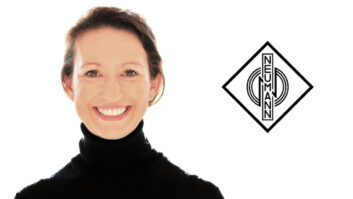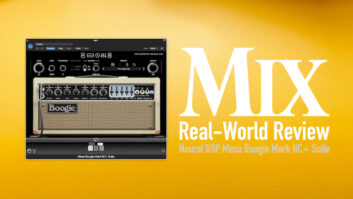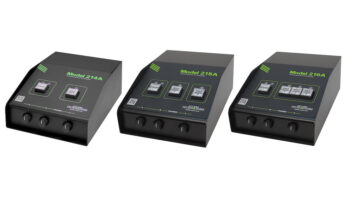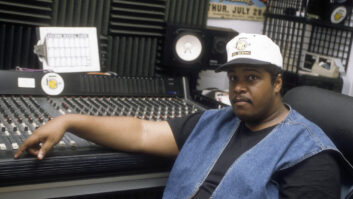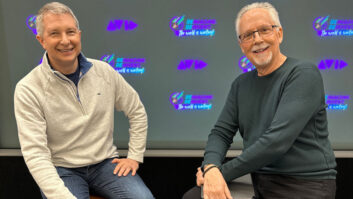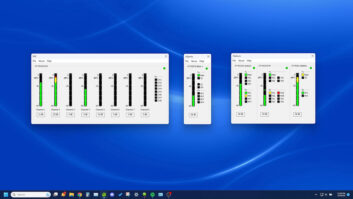At Frankfurt’s Musikmesse/ProLight & Sound in April, five months after his appointment as CEO of Loud Technologies, Pro Sound News Editor Frank Wells sat down with Mark Graham to discuss the changes made so far and his vision going forward. This is a full transcript of the discussion.
PSN: There’ve been quite a few changes so far in your tenure.
GRAHAM: Yes, it probably seems that way. We did an EAW distributor meeting a couple days ago, and then a Mackie and Ampeg [event] and the language I used with our customers was, we’re running; we’re not walking. And the reason is, these businesses are actually in a really nice position, each one of them, and [that ’s] what attracted me over.
[Sun Capital Partners, the equity firm that holds Loud] said, ‘We need an industry guy.’ I said, ‘You’re going to have to put some capital into this business and you’re going to have to let me invest it. It’s all about new products. And you’re going to have to let me structure these things, because each one of [Loud’s] brands is unique, awesomely unique, and innovation grew the companies and so if you want to be successful, you’ve got to let them [innovate]. You’re going to have to allow me to do these things.’ They’ve given me all that I asked for and so you see the face of change.
I don’t know how much you’ve picked up on, but you see that I immediately came in and I decentralized Loud’s management structure. For unique, individual brands, [the prior centralized structure was] terrible. I want Martin to stand on its own, I want EAW to stand on its own, and I want them to compete. They come to the market in their own way; homogenizing that is just a losing strategy. Let ‘em do it, get the critical level of investment back where it needs to be in R&D and marketing. I have to tell you, our brand teams are solid and deep; it’s easy to show up and be the hero—they just grab it and run. Now the pace is just churning. You watch: the products that are coming, lots of them, real innovation.
PSN: The last few executives running Loud came from outside the industry…
GRAHAM: …Finance guys, they’re very good guys. Rodney [Olson], who is my predecessor, did a great job through all the [global] economic turmoil, a very respectable job. But, what Sun told me right off the bat was, ‘We need a vision.’
The first, probably, 3 1/2 – 4 months of my job was working primarily with Sun to get the capital and to get a business plan in place that reinvested more. They [Sun] gave me everything I asked for. I was expecting and I was armed for some big battles. Oh, they put me through my paces appropriately, but I am having such a blast. Think about it, we have really cool brands with great innovative technology, [the] people are fabulous and [we have] money to invest.
PSN: You got to avoid the parts of Loud’s history where the manufacturing was largely migrated overseas, where they had to deal with the economic downturn internationally…
GRAHAM: … exactly …
PSN: … so you get to come in and just …
GRAHAM: … I guess, just have fun. Trying to outsource EAW production to China was a bad idea. They’d already started moving it back, so it was easy for me to go, ‘Right, keep doing that.’ I’m having the best time of my career. Sometimes as you step up, the pressure goes up and it becomes business instead of doing what you’re passionate about. I’m in such a lucky position because I get to do both and I have a lot of fun. I’ve got to give Sun Capital great kudos; they’ve just been an amazing company to work with. I have a great relationship [with them, and they’ve placed] a lot of confidence and trust in me. It allows me to come in and lead the way I want to lead, strategically go about businesses the way I want to do it, organize business the way I think is optimal and so, how can I do anything but just have a good time?
PSN: So, their main charge to you was…?
GRAHAM: Grow the business. The formula’s not hard, develop new products and…
PSN: …they can’t be ‘me too’ products…
GRAHAM: No. And I wouldn’t have been interested in a commodity organization. If you’re really about just following and hitting a price point, it’s not my game. But if you want to innovate and you want to really energize a market and do exciting things, well, we can have fun with that.
PSN: You have a pure engineering background, don’t you?
GRAHAM: Yes, I’m an EE, although I have to confess to you, I’ve never worked a day as an engineer. I’ve always come up on the technical, strategic side of leadership. I have led the R&D teams, I’ve led the marketing team. So truthfully, it’s probably not completely accurate to call myself an engineer. I’m really a strategist.
PSN: But the technical background can’t hurt in an industry like ours.
GRAHAM: Well, it allows me to understand what the technology is and how it’s in play. Like so many of us, we’re here because we love the audio business, right? Could we have chosen different career paths and perhaps been rewarded economically better? Yes. But we’re here because we love it. I love audio. I’ve got enough engineering chops to be able to understand how it works and then I get to work in the industry I love. So it doesn’t get any better.
PSN: What’s the path going forward for the Loud brands? Can you talk about direction?
GRAHAM: I will tell you this, I hope you and I get to have a conversation formally or informally about a year from now and we’ll see what we have to talk about because it will be pretty cool. When I came in, I wasn’t sure how deep the teams were. I was sort of preparing myself that I might have to do some work there. Thankfully, I’m very pleased with the caliber of our people—the passion, commitment, ability in every part of the organization was surprisingly good, and so that piece is in place.
Strategically, what we’re going to do is, we are legitimately, very seriously, going to innovate. You will see a lot of new product out of us. It’ll start to hit in the fall of 2011, but it takes a little more incubation time to get real innovation out, so early next calendar year, you’ll see some big things out of all brands. Across the board, each brand has to stand alone and succeed, and as I decentralized, I put them in that place: You are your own brand, your own entity; my job is to help you flourish. You’ll see each brand driving [forward] in their own unique way.
You’ll see a lot of innovation on the marketing front as well. I’m really impressed with the caliber of the marketing team, but again, we needed a little bit of investment and at the highest level—guidance, but sort of unleashing them to do the things they’re great at. I’m very excited about some stuff that they’ve got cooking.
The biggest area is product innovation. My goal is to tune the machine up and get it growing. The engine is product innovation. And then marketing.
PSN: Are all the brands profitable?
GRAHAM: Yes. Yes.
PSN: Can you review them separately?
GRAHAM: Absolutely. It’s a very important question. They stand alone. They have their own P&L. And that is a bit of a change. It’s not so outwardly visible, but I’m not interested in a homogenized, matrix-driven organization. I think it’s fantastic for those brands to go [independent] and they actually love it. You might think maybe the scrutiny [would be unwelcome], but the leaders in these brands are reacting positively, ‘Let us stand on our own and invest as we see opportunity and can justify it.’ So yup, every month, we review every brand independently, each with its own leaders and its own P&L.
PSN: Unlike the days when the company was public, you may not want to reveal details about overall profits, but what will you share about your bottom line—what are the trends?
GRAHAM: Well, it’s a great question because I will tell you, we just completed our strongest quarter in four years, set records. Martin Audio had its best quarter ever. We grew year over year, we were up 20 percent as an overall business. So we are on a nice roll. I can’t take credit for that; this is all stuff that the team has had in play, of course, but boy, is the momentum in the right direction, and strongly in the right direction.
PSN: Martin’s growth has to be based on more than just their new MLA (Multi-cellular Loudspeaker Array] product.
GRAHAM: You want to think it’s MLA, because there is so much energy around that product, but, truthfully, we’re putting up strong numbers across the entire range. I feel it’s probably the MLA halo effect. You’ve just upped the energy on the whole brand and suddenly you’ve got a lot of people wanting to do business with you.
PSN: The clients perhaps saying, ‘That’s really cool, but right now I need a different, smaller solution…’
GRAHAM: …Yes, how many people can buy an MLA rig, right? So you start looking at the Blackline and OmniLine and some of these other really quite interesting products, and we’ve got a lot of people knocking on our doors. My phone is ringing and that, of course, that’s fun. So I think you’re right on. The MLA is the engine, but it’s got a nice halo around everything else. It’s given Martin Audio a platform. They’ve got a nice technology there and people get it real quick. You start to get your head around that and then they go, ‘Oh, wonder what they’ll do with that next? Oh, wouldn’t that be interesting?’ So you can real quick see the path that’ll head [down] and I want to be on that train.
PSN: When Loud, which already owned EAW, bought Martin Audio, a second premium live sound brand, there was a lot of speculation in the industry about how well that would work, having two major sound reinforcement lines within one company.
GRAHAM: After having gotten in and looked at it and evaluated it, you realize that they are so culturally unique and their whole approaches to solving problems are dramatically different, that they live quite well on their own and the best thing to do is just let them compete. One of the things I want everybody to know is there’s no way I’m favoring either Martin Audio or EAW. I’m investing in both, I’m doing everything I can to help both be as successful as they absolutely possibly can and it feels to me like they’re able to live quite happily that way.
PSN: They are taking unique approaches to problem solving. EAW has the CSA [Concentric Summation Array] and EAW focusing processing, Martin has the MLA. As with the companies, the products themselves have a different character to them.
GRAHAM: Different character is a good way to say that, I think. The other thing to keep in mind is they live at the very top of the pyramid. In that space, there’s a lot of room for differentiation. As you move down that pyramid, there’s a broader and broader market where it’s increasingly less differentiated to greater commodity. The positions they live in right now, it’s working quite well. I’m happy to let them just be what they want to be.
PSN: Mackie led the market into new areas with quality and value, becoming ubiquitous, but also finding itself competing in a now-crowded retail market segment. Where do you see Mackie fitting into the continuum of Loud and its customers?
GRAHAM: It’s interesting how that takes different flavors [depending on] where you go in the world. Let’s go to Asia. [There, Mackie is] on the high end. It’s the rental companies that are buying Mackie. You don’t have garage bands. It’s real companies that are carrying SRM450s and put them on a stick and that’s actually what that business is. You go to China and no exaggeration, you want a mixer, they don’t say “Oh, I’ll need an 8-channel mixer,’ they’ll say, ‘I need an 8-channel Mackie.’ And so there’s that different thinking regionally but, at its core, what I think Mackie is, is a value play. But it’s a value play with a lot of innovation and a lot of personality.
Some of the things we’ve got in the pipeline that you’ll see, hopefully, some in the fall, definitely by the time we’re knocking into the new calendar year, you’ll see this really get defined. I think you’ll see Mackie get its stride back.
One of the first things I did when I sat down with [the Mackie team was] I said, ‘Show me the big projects. What do you do that tells the market what your brand is? What are you doing that defines it and sets the standard out there?’ Their eyes light up and they get excited. [My approach was], ‘I want to know what drives your brand.’ If you can’t go out and energize a market with your brand, then you’re a commodity.
PSN: There’s a corner of [the ProLight&Sound] Hall 8 with exhibitors who’ll help you do just that, who’ll put your name on anything you like.
GRAHAM: Exactly. There’s a lot of people doing that. But that’s not what Mackie is. You can’t believe how energized all these engineering and marketing people are. It’s not that I’m any genius, but they’re like, ‘Somebody that gets this and they’re putting money in. Hallelujah.’
PSN: Will there be any brand expansion, any new lines? Either through acquisition or in a category you’re not in now that you think needs its own brand?
GRAHAM: Everything’s on the table. I’m a strategist. For a couple of years here, we’re going to get our base back. The conversation usually goes like this. I will say, ‘Who are your core customers? Okay now, tell me how you’re going to delight them.’ I’m not saying, ‘How do we expand, where’s a tangential niche that we could leverage?’ I’ve had that conversation a lot in past jobs. This isn’t the time for that one here.
I really use that language a lot. I want them to delight their core. Who are your guys? Blow them away because you can. Just remind them that you understand them and get it. There’s a lot of business growth in that. I told you there’s, no exaggeration, 20 percent up over last year, best quarter in four years. We’re already doing this, so now come in and [prove], ‘I understand and delight you, my core customer.’ It ought to be good stuff.
PSN: Any hints at all on the directions innovation will lead?
GRAHAM: I think you could look at any of the brands and can probably guess some things. EAW, right now, has I think, a very compelling install product line. I quite like it. There’s some good stuff in there. QX speaker, if you haven’t heard that, go hear it. Seriously good. You look at Mackie, we’ve got some very venerable products; the SRM [portable loudspeaker] product line, a lot of successful mixers. Even into this day, over history, the sell was great. The muscle of those brands and models are surprisingly strong, even more than I even imagined coming in. So you can imagine, you take that with a bunch of investment and innovation and where do you go with it? There is some cool stuff in there. Martin has really proven an amazing technology in the multi-cellular strategies. What do you do with that? [When] it’s not a mil, a mil 5 to get into [such a] system, that suddenly expands the application for that [technology].
PSN: The question becomes, perhaps, does that same technology and software lend itself to say, a column that could be programmed in an install situation…
GRAHAM: …It very might well. Exactly. You think about the advantages of that—what multi-cellular does is it allows you to have a much better control of the energy on the audience. You’re thinking, ‘Here’s my audience plane or planes and I articulated into that keeping energy off stage, filling nulls, adjacent areas that are active with people but not part of my performance.’ It’s a really compelling technology. I’ll give you an example: In Belgium, [MLA’s] done so well because they have very strict sound police there. It’s done so well there, they’ve interviewed our application guy on TV because it solves this problem in these tight public spaces where there’s a live performance adjacent to a commercial business that isn’t part of it. When the restraurant owner says, ‘Look, I don’t want you ruining my café with a blast [of sound]’ and suddenly you’re able to give a substantial amount of energy rejection in their space, yet keep an audience space very active, that gets really interesting. [It makes you think], ‘Man, how do I get the cost down? How do I get that into more places?’ So we’re expanding our engineering teams to get more product in that space.
PSN: What’s the employee count of Loud, roughly?
GRAHAM: Around 250, somewhere in there. Head count has not been my focus at all. The structure actually is very healthy; we’re nicely profitable. So I haven’t had to focus on, ‘Oh, are we fat somewhere?’ The bigger concern is frankly, too few resources in places and I’ve been more driven on plugging holes, getting people in the right place.
PSN: But since you’re profitable, you can afford to do that?
GRAHAM: Yes, and a very good point, in the sense that for me, it allows me to aggressively pursue opportunity.
PSN: Is there anything else that I didn’t ask?
GRAHAM: What I hope you get out of the dialogue is a lot of energy and excitement. I can tell you I’m sincerely having a blast and I can tell my teams are, too. And companies having fun will do great things. Let’s talk again in six months, 12 months, and we’ll see if we’ve delighted anybody.
